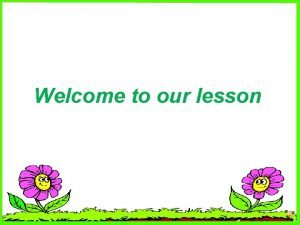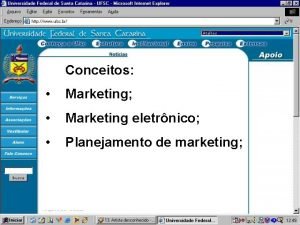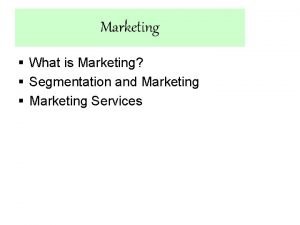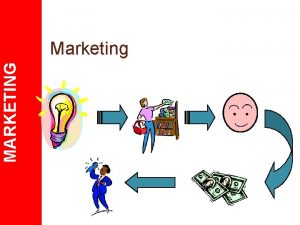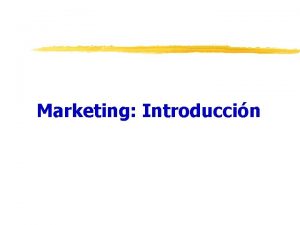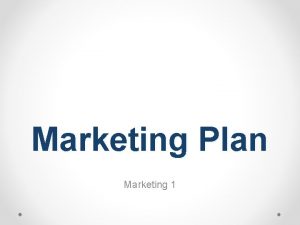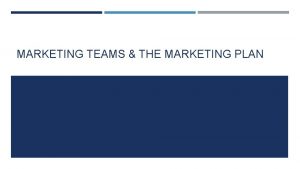Marketing Plan Welcome to Marketing A marketing plan
























- Slides: 24

Marketing Plan Welcome to Marketing

§ A marketing plan is a business document outlining The Marketing Plan your marketing strategy and tactics. It's often focused on a specific period of time (i. e. over the next 12 months) and covers a variety of marketing-related details, such as costs, goals, and action steps.

WHAT IS MARKETING? § VALUE § FUCTIONAL § EXPERIENTIAL § PSYCOLOGICAL

1. 4 THE MARKETING PLAN 2. 3. Figure 2. 1 Marketing and Promotions Process Model 4.

1. Opportunity can come from a change in technology and the Macroenvironment

OR Opportunities can also come from competitors

2. THE TARGET MARKETING PROCESS

8 § Dividing a market into distinct groups with common needs, who respond similarly to a marketing situation § Criteria § Geographic segmentation: Markets are divided into different geographic units § Demographic segmentation: Dividing the market on the Market Segmentation basis age, sex, family size, education, income, and social class § Psychographic segmentation: Dividing the market on the basis of personality, lifecycles, and/or lifestyles § Behavioral Segmentation: Dividing consumers into groups according to their usage, loyalties, or buying responses to a product § Benefit Sought: Grouping of consumers on the basis of attributes sought in a product

Behavioral

Determine how many segments to enter Selecting Target Market Determine which segments offer the most potential

Undifferentiated marketing • Ignoring segment differences and offering just one product or service to the entire market Market Coverage strategies Differentiated marketing • Involves marketing in a number of segments, developing separate marketing strategies for each Concentrated marketing • Selecting a segment and attempting to capture a large share of this market

Positioning Strategies Attributes & Benefits Price /Quality Use/Application Product Class Product Users Competitors Cultural Symbols

Positioning by Product Attributes & Benefits • Talks about specific characteristics and benefits offered • Salient attributes

Positioning by Price/Quality • Reflects the image of a high quality brand, while cost, if not irrelevant, secondary • Product quality must reflect the high price

Positioning by product Class • Competition comes from outside the product class/category. This positioning tries to battle it

Positioning by Competitors • Position their products positioning against the competitor’s

Positioning by Symbols

18 § Altering a product’s or brand’s position due to: § Declining or stagnant sales Repositioning § Anticipated opportunities in other market positions § Difficult to accomplish because of entrenched perceptions and attitudes toward the product or brand

Repositioning • Change target market • Change brand image

20 3. MARKETING PLANNING AND PROGRAM / THE 4 P DECISION § Product symbolism: Refers to: § What a product or brand means to consumers § What consumers experience in purchasing and using a product Product Decisions § Branding § Building and maintaining a favorable identity of the company and its products § Packaging § Provides functional benefits such as economy, protection, and storage

21 Builds and maintains brand awareness and interest Develops and enhances attitudes toward the company or product Branding Builds relationships between the consumer and the brand Brand identity: Combination of name, logo, symbols, design, packaging, and image of associations held by consumers Brand equity: Intangible asset of added value

22 § Price variable - Refers to what the consumer has to give in exchange for a purchase § Factors that determine price Price Decisions § Costs § Demand factors § Competition § Perceived value § Product quality § Advertising Pricing strategy for new brands: Price Skimming Price Penetration

23 § Interdependent organizations involved in making a product or service available for use Marketing Channels § Direct channels: Directly deal with customers § Driven by direct-response ads, telemarketing, the Internet § Used when selling expensive and complex products § Indirect channels: Network of wholesalers and/or retailers

24 Promotional Strategies § Push Strategy: Making a product and pushing it onto consumers § Pull strategy: Asking the consumers what they want, raise demand make them pull the product.
 Wise men three clever are we
Wise men three clever are we Letter to exchange student
Letter to exchange student World university of bangladesh
World university of bangladesh Welcome 123
Welcome 123 Tour guide greetings
Tour guide greetings Welcome we will begin shortly
Welcome we will begin shortly Welcome we are so glad you are here
Welcome we are so glad you are here Welcome we are glad you are here
Welcome we are glad you are here Atithi devo bhava in nepali
Atithi devo bhava in nepali Hello welcome to my class
Hello welcome to my class Welcome in english class
Welcome in english class Welcome to new session 2020-21
Welcome to new session 2020-21 Welcome english class
Welcome english class Picat welcome
Picat welcome Welcome to russia meme
Welcome to russia meme Welcome to romania
Welcome to romania Welcome to regina
Welcome to regina Welcome 2nd quarter
Welcome 2nd quarter Welcome to quarter 2
Welcome to quarter 2 Welcome to pune in marathi
Welcome to pune in marathi Welcome to sunday worship
Welcome to sunday worship Assaignment
Assaignment Welcome to our online class
Welcome to our online class Unscramble
Unscramble Welcome to our lesson
Welcome to our lesson
























